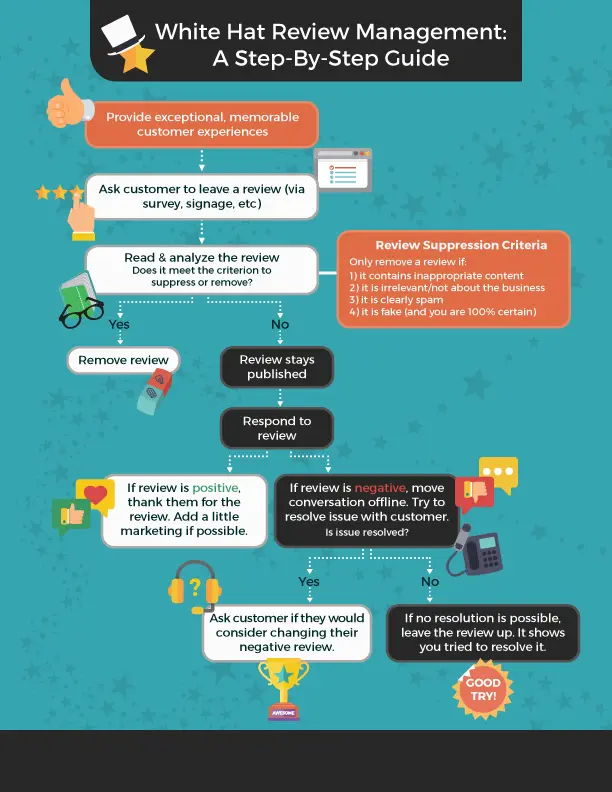Why Your Business Needs to Stop Removing Reviews Jump to heading
1 People Can Tell When Reviews Are Filtered Jump to heading
Consumers today are quite discerning when it comes to online reviews. A study by Econsultancy in 2012 found that 68% of consumers trust reviews more when they see a mix of both good and bad scores. This statistic highlights a critical point: customers are not easily fooled by an all-positive facade. They understand that no business is perfect, and when they see only glowing reviews, it raises suspicions. According to a 2015 study by Reevoo, 95% of consumers suspect censorship or fake reviews when they don’t see any negative scores. In essence, if all your reviews are positive, it might be doing more harm than good by making your customers distrustful.

2 It Looks Like Your Business Has Something to Hide Jump to heading
When your business has no negative reviews, it can seem like you have something to hide. According to Webrepublic, 30% of consumers think reviews are fake if there are no negative ones. Moreover, Brightlocal's 2016 report shows that only 8% of consumers expect a business to have a 5-star rating before they will consider using them. This means that the absence of any negative reviews can lead potential customers to assume your reviews are manipulated, which can damage your credibility. Customers prefer authenticity over perfection, and a few bad reviews among the good ones make your business appear more transparent and trustworthy.
3 Removing Reviews Angers Customers Jump to heading
Customers who want to share their experiences will find it frustrating if they can’t leave a review, whether positive or negative. This frustration can lead to negative consequences for your business. Even if you think you are removing negative reviews, customers can still leave them on unverified listings and profiles. This means that bad reviews don’t just disappear; they might just move to a place where you have less control. Ignoring or removing negative feedback can make customers feel unheard and undervalued, which can damage your reputation and customer loyalty.
4 It Shows a Lack of Customer Care Jump to heading
Not allowing feedback can give the impression that your business doesn’t value its customers. If customers feel like they can't leave a review or that their feedback isn't appreciated, they may assume that you don’t care about customer service. This perception can deter them from visiting your business. Customers are more likely to engage with businesses that show they are open to feedback and willing to make improvements based on customer suggestions. Allowing and responding to reviews, even negative ones, shows that you value your customers' opinions and are committed to providing good service.
5 You Miss the Chance to Win Back Trust Jump to heading
Negative reviews can actually be an opportunity for your business. When you respond to a negative review, you have a chance to address the customer's concerns and show that you care about their experience. Publicly responding to reviews can help win back unhappy customers and demonstrate to others that you are committed to resolving issues. This approach can enhance your reputation and show potential customers that you are serious about customer satisfaction. It also allows you to control the narrative and potentially turn a negative experience into a positive one by addressing and resolving the issue.
6 Missing Out on Valuable Feedback Jump to heading
Negative feedback can provide valuable insights into areas where your business can improve. While some customers may have unrealistic expectations, others can offer constructive criticism that can help you identify and address oversights. Ignoring or removing these reviews means missing out on opportunities to better your business. Constructive feedback is a crucial tool for growth, and addressing it can help you improve your products or services, ultimately leading to a better customer experience.
When It’s Okay to Filter Reviews Jump to heading
1 Inappropriate Content Jump to heading
Reviews that contain graphic material or inappropriate language should be removed. Most review platforms have policies in place to handle this, but if they miss it, you can flag the review as inappropriate. It's important to maintain a professional and respectful environment for your customers.
2 Irrelevant Reviews Jump to heading
If a review doesn’t mention your business or its services, it’s okay to suppress it. Sometimes customers use the review section to ask questions or share experiences unrelated to your business. These reviews do not add value and can be confusing for other customers.
3 Spam or Competitor Plugs Jump to heading
Reviews that are clearly spam or meant to promote another business should be removed. If a review mentions a competitor or seems to be a case of mistaken identity, it is fair to suppress it. Spam reviews can clutter your review section and detract from legitimate feedback.

4 Fake Reviews Jump to heading
If you know a review is fake or planted by a competitor, it’s acceptable to remove it. Fake reviews can be misleading and unfairly damage your business’s reputation. Use tools like Review Skeptic, backed by Cornell University research, to help identify fake reviews. Unfortunately, reviews can sometimes be used as blackmail, highlighting the importance of effective review management and reputation management software.


How to Practice White-Hat Review Management Jump to heading

-
Provide Exceptional Customer Experiences
- Ensure that your customers have a positive experience with your business. Happy customers are more likely to leave positive reviews.
-
Encourage Reviews
- Use in-store signs, surveys, and other methods to ask customers to leave reviews. Make it easy for them to share their feedback.
-
Analyze Reviews
- Determine if a review meets the criteria for removal (e.g., inappropriate content, spam). If it does, remove it; if not, keep it published and respond accordingly.
-
Respond to Reviews
- If the review is positive, thank the customer for their feedback. If the review is negative, try to move the conversation offline to address their concerns. If you can resolve the issue, ask the customer to update their review. Even if the customer doesn’t change their review, others will see that you took steps to remedy the situation.
Taking the High Road in Review Management Jump to heading
At the end of the day, consumers can tell when a business is grooming its reviews. An all-positive review profile can appear suspicious and less credible. From a consumer’s perspective, it is better to see a business with a mix of reviews, mostly positive but with some negatives as well. This shows that the business is genuine and open to feedback. Proper review management involves addressing negative feedback constructively and transparently, which can actually enhance your reputation. It demonstrates that you value your customers and are committed to improving their experience.
References Jump to heading
- Birdeye - https://birdeye.com/blog/online-reviews/
- Sendlane - https://www.sendlane.com/blog/online-review-monitoring-
- Sprout Social - https://sproutsocial.com/insights/online-review-management/
- PinMeTo - https://www.pinmeto.com/blog/monitor-online-reviews
- Birdeye - https://birdeye.com/blog/review-monitoring/
- Nextiva - https://www.nextiva.com/blog/review-management.html
- Mentionlytics - https://www.mentionlytics.com/blog/review-monitoring/
- ReviewTrackers - https://www.reviewtrackers.com/blog/online-review-management/








